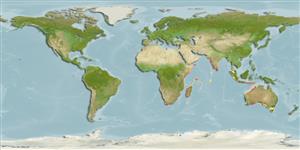>
Carangiformes (Jacks) >
Carangidae (Jacks and pompanos) > Trachinotinae
Etymology: Trachinotus: Greek, trachys, -eia, -ys = rough + Greek,noton = back (Ref. 45335).
More on author: Smith.
Environment: milieu / climate zone / depth range / distribution range
पारिस्थितिकी
समुद्री; खारा प्रवाल-भित्ति संयुक्त; गहराई सीमा 20 - 50 m (Ref. 28016). Tropical
Indian Ocean: Gulf of Aden and Oman, Mozambique and South Africa to western Indonesia.
आकार / वज़न / Age
Maturity: Lm ? range ? - ? cm
Max length : 92.0 cm TL पुल्लिंग / अलिंग; (Ref. 3287); अधिकतम प्रकाशित वज़न: 14.1 kg (Ref. 3287)
पृष्ठीय रीढ़ (सम्पूर्ण) : 7; पृष्ठीय सौफट रेज़ (सम्पूर्ण) : 21 - 23; गुदा कांटा: 3; ऐनल सौफट रेज़: 19 - 21.
Adults inhabit coastal areas with reefs or rocky outcrops (Ref. 3197). They are found normally in pairs on reefs but may be solitary or form schools (Ref. 5213, 90102). Juveniles in sheltered bays. Adults feed on mollusks (mussels) and crabs (Ref. 5213).
Life cycle and mating behavior
परिपक्व अवधि | पुनरुत्पत्ति | मछलीऔ का अंडे देना | अंडे | Fecundity | लार्वा
Smith-Vaniz, W.F., 1984. Carangidae. In W. Fischer and G. Bianchi (eds.) FAO species identification sheets for fishery purposes. Western Indian Ocean fishing area 51. Vol. 1. [pag. var.]. FAO, Rome. (Ref. 3287)
IUCN Red List Status (Ref. 130435: Version 2024-1)
Threat to humans
Harmless
Human uses
मात्स्यिकी: लघु वाणिज्य; आखेट मत्स्य: हां; जलजीवालय: सार्वजनिक लजीवालय
साधन
Special reports
Download XML
इंटरनेट स्रोत
Estimates based on models
Preferred temperature (Ref.
123201): 18.3 - 28.2, mean 26.2 °C (based on 49 cells).
Phylogenetic diversity index (Ref.
82804): PD
50 = 0.5000 [Uniqueness, from 0.5 = low to 2.0 = high].
Bayesian length-weight: a=0.01995 (0.00854 - 0.04661), b=2.87 (2.69 - 3.05), in cm total length, based on LWR estimates for this Genus-body shape (Ref.
93245).
Trophic level (Ref.
69278): 3.4 ±0.35 se; based on food items.
लौटाव (Ref.
120179): माध्यम, न्यूनतम जनसंख्या दुगनी होने का समय 1.4 - 4.4 वर्ष। (Preliminary K or Fecundity.).
Fishing Vulnerability (Ref.
59153): High vulnerability (57 of 100).
Nutrients (Ref.
124155): Calcium = 36.3 [16.0, 66.7] mg/100g; Iron = 0.608 [0.341, 1.244] mg/100g; Protein = 19.4 [17.4, 21.4] %; Omega3 = 0.103 [0.063, 0.184] g/100g; Selenium = 40.6 [21.7, 82.3] μg/100g; VitaminA = 25.4 [6.5, 92.8] μg/100g; Zinc = 0.965 [0.641, 1.400] mg/100g (wet weight);
